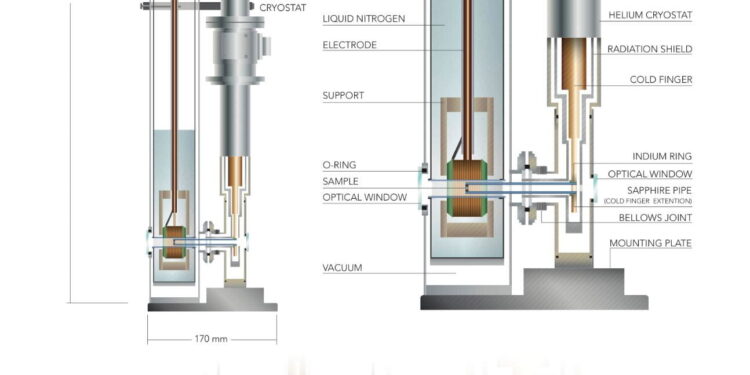A graphic illustrates the configuration and functions of the Rice Advanced Magnet with Broadband Optics, or RAMBO, a unique instrument that allows researchers to use pulsed laser spectroscopy to examine the behavior of materials that are simultaneously cooled near absolute zero and subjected to a massive pulse of magnetic energy. Credit: Junichiro Kono Laboratory
Materials with improved thermal conductivity are critical to the development of advanced devices to support applications in communications, clean energy and aerospace. But to design materials with this property, scientists must understand how phonons, or quantum units of vibration of atoms, behave in a particular substance.
“Phonons are very important for studying new materials because they govern several material properties such as thermal conductivity and carrier properties,” said Fuyang Tay, an applied physics graduate student working with the Rice Advanced Magnet with Broadband Optics (RAMBO), a tabletop spectrometer. in the laboratory of Junichiro Kono at Rice University. “For example, it is widely accepted that superconductivity results from electron-phonon interactions.
“Recently, there has been increasing interest in the magnetic moment carried by phonon modes that exhibit circular motion, also called chiral phonons. But the mechanisms that can lead to a large phonon magnetic moment are not well understood. “

Andrey Baydin (left) and Fuyang Tay. Credit: Gustavo Raskosky/Rice University
Today, an international team of researchers led by Felix Hernandez of the University of São Paulo in Brazil and Andrey Baydin, a research assistant professor at Rice, published a study detailing the complex connections between the magnetic properties of these quantum whirling dervishes and the underlying topology of a material of the electronic band structure. , which determines the range of energy levels that electrons possess.
This discovery adds to the growing body of knowledge about phonons, opening the door not only to more efficient manipulation of phonons via magnetic fields, but also to the development of advanced materials.
In a previous study, Baydin and his colleagues applied a magnetic field to lead telluride, a simple semiconductor material. In doing so, they found that the phonons stopped vibrating linearly and became chiral, moving in a circular motion.
“Chiral phonons interact with each other differently than phonons that move linearly,” Baydin said. “If we understood the properties of these interactions, we could use them. Different properties could realize different potential applications in materials.”
After noticing that the magnetic moment of chiral phonons was quite weak in the material they first focused on, the group wondered whether changing the material’s topology (or electronic band structure) would have an impact on the magnetic properties. To answer this question, the researchers tested a new material called crystalline topological insulator.
“We took lead telluride and added tin to it,” Baydin explained. “If you add enough of them, something called band inversion occurs, creating topologically protected surface states. These materials are fascinating, because they are bulk insulators but have conductive electronic surface states – a very promising feature that could be exploited in new electronic devices.”
Additional experiments revealed that the magnetic moment of chiral phonons was two orders of magnitude larger in the topological material than in the material without such an electronic topology.
“Our results reveal compelling new insights into the magnetic properties of phonons in this material and highlight the complex connection between the magnetic properties of chiral phonons and the topology of the material’s underlying electronic band structure,” Baydin said. He added that the group plans to conduct further experiments to better understand other aspects of phonon behavior in the future.
Tay added that these results, which demonstrate that the phonon magnetic moment is significantly enhanced in topological materials, can help materials scientists research and design materials with larger phonon magnetic moments, according to the needs of different device applications.
“This observation provides new insights into how to control and manipulate the properties of phonons to change thermal conductivity,” Tay said. “Moreover, the interaction between chiral phonons and the topology of the electronic structure raises the possibility that the topological phase may be influenced by phonon control.”
More information:
Felix GG Hernandez et al, Observation of the interaction between phonon chirality and electronic band topology, Scientists progress (2023). DOI: 10.1126/sciadv.adj4074
Provided by Rice University
Quote: Electronic pathways can improve the magnetism of collective atomic vibrations (December 16, 2023) retrieved on December 17, 2023 from
This document is subject to copyright. Apart from fair use for private study or research purposes, no part may be reproduced without written permission. The content is provided for information only.



